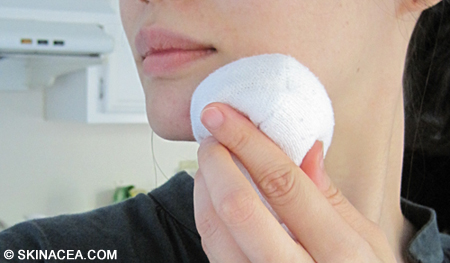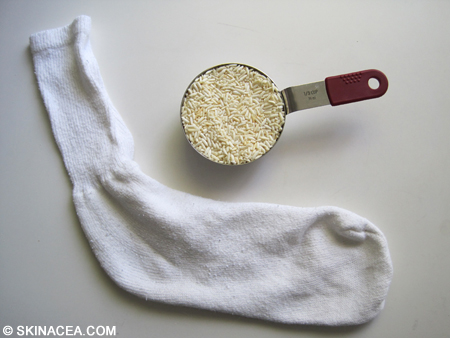How to Make a "Rice Sock" Warm Compress
An easy warm compress for spot treating acne |

A rice sock warm compress for spot treating acne, especially cysts!
A warm compress is one of the best spot treatments for acne, especially the kind of pimples that are big, deep, and painful like cysts. When applied frequently throughout the day, a warm compress can help emulsify the clog in your pore and help your skin clear the pimple out faster. It is not a guaranteed solution to get rid of acne, but it certainly helps with pesky zits and is a low-cost, low-risk spot treatment to try.
Unfortunately, when people think of warm compresses, they often think of soaking a cotton pad in warm water over and over again. This process is messy and inefficient - water drips down your face and cools way too fast before it gets anything done. Looking for a better, easier to use, and less messy warm compress? Here is where a "rice sock" warm compress saves the day!
A "rice sock" warm compress can be re-used and re-heated frequently. It retains heat for a long time and is not messy to use. Best of all, it is extremely cheap and easy to make.
Here are the 3 simple things you need to make this warm compress:
- 1 clean sock with no holes in it
- 1/3 cup of uncooked rice (or a small handful)
- A microwave
Scroll down for instructions on how to make and use this easy warm compress so none of your acne spots go without treatment again!
Step 1: Get your supplies together

You'll need one clean sock and some uncooked rice
Get a clean sock and make sure there are no holes in it. You'll need approximately 1/3 cup of uncooked rice, but you can add more or less depending on how big or small you want your warm compress to be. The rice can be any kind of rice - brown rice, white rice, etc. I use the cheapest rice I can find since it doesn't really matter.
Step 2: Put the rice in the sock

Put the sock over a glass so it's easier to pour in the uncooked rice
Place the clean sock over a tall, sturdy glass. This makes it easier to pour the uncooked rice into the sock without spilling it everywhere.

Pour the rice into the sock
Once you have the sock over the glass, carefully pour the uncooked rice into the sock. It's best to do this over a counter top to minimize clean up in case the rice does spill.
Step 3: Knot the sock at the top

Rice sock warm compress
Carefully remove the sock (now filled with rice) from the glass. Knot the top of the sock to prevent the rice from spilling out.
Step 4: Microwave and re-heat as needed
Now that you have the rice sock made, pop the entire thing in the microwave for 30 seconds. If your rice sock is bigger, you might want it heat it for 35-40 seconds. If it is smaller, you might want to heat it for 20-25 seconds instead. It will depend on the size of your rice sock warm compress and also on the power of your microwave, so adjust the microwaving time accordingly.
When you take the rice sock out of the microwave, shake it a few times to make sure the heat is evenly distributed. Be careful when you are doing this, as the rice sock might be hotter than you expect it to be.
Step 5: Put the rice sock on your pimple
Before applying the rice sock warm compress to your face, test it on your neck to make sure it's not too hot. If it's too hot, let it cool for a bit before applying to your skin. If 30 seconds in the microwave heats the rice sock too much, put it in for 25 seconds the next time. Adjust the microwaving time as needed.
Once the rice sock is at a comfortable temperature, apply the rice sock warm compress to your acne. Hold the rice sock on the pimple until the compress loses heat. When the rice sock cools, re-heat it again in the microwave and continue applying the warm compress to your skin as long as you wish.
The more frequently you use the warm compress, the more effective it will be. A hotter warm compress won't necessarily get rid of a pimple faster and can even damage your skin (ex. drying out the surface and making it peel off), so make sure your warm compress isn't too hot to the touch. It should be warm, but not uncomfortable to hold against your skin. If your skin starts to feel irritated or red in any way, give it a break from the warm compress.
What to expect from using this warm compress?
When I use this rice sock warm compress on a pimple that is just forming, it helps prevent the pimple from getting bigger and turning into a full-blown zit. This will be different for everyone though. I generally feel my pimple, especially the big and painful kinds, start to improve and go away after 2-3 days of regularly using the rice sock warm compress.
It's also a good idea to switch the rice into a clean sock once a week. Your face has oils and the sock eventually collects dust, so it's best to maintain proper hygiene with the rice sock. As for the rice itself, once it starts to smell "burnt" or "cooked", throw out the old uncooked rice and use new uncooked rice. In my experience, microwaving the uncooked rice has never cooked it to the point where the rice turns soft though. You do want to keep the rice sock dry and avoid getting it wet so it stays fresh.
If you have any questions about making or using this rice sock compress, please comment below or send me an email. I would love it if you shared your results with using this type of warm compress as well!
Good luck using this rice sock warm compress as a cheap and easy acne spot treatment!
Last updated: December 3, 2012
How to Get Rid of Ingrown Hairs
Back « How To's
Related Links:
- How to Use Retinoids the Right Way
- A Comprehensive List of Acne Treatments
- Using Chemical Peels as an Acne Treatment
- How to Wear Sunscreen the Right Way
- Skin Care Order: What Skin Care Product Goes on First?
